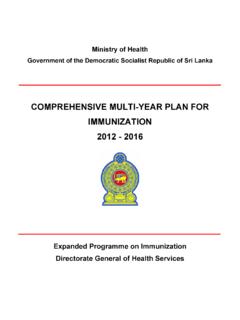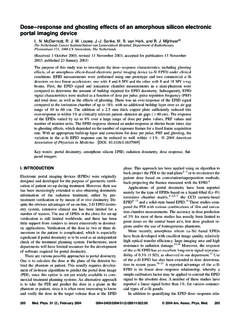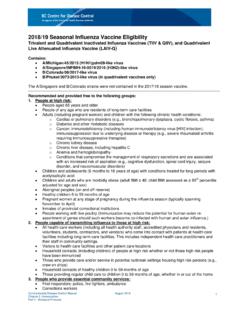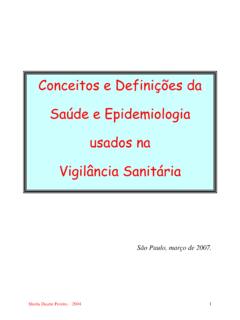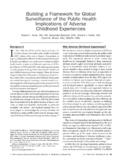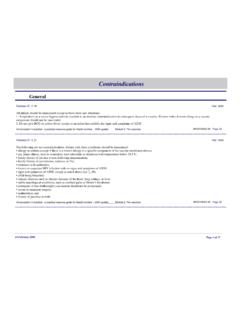Transcription of Ministry of Health - Sri Lanka - Epid
1 Ministryof Health -Sri LankaNationalGuidelinesGuidelineson Management of Dengue Fever &Dengue Haemorrhagic FeverInAdultsInCollaborationwiththeCeylo nCollegeofPhysiciansRevised and expanded editionNovember2012 Theguidelines,publishedinNovember2012,su persedethepreviousguidelinesonManagement ofDengueFever/DengueHaemorrhagicFeverpub lishedbytheEpidemiologyUnit, CommitteeDr Nirmalee GunawardaneConsultant PhysicianTH KandyDr Ananda WijewickramaConsultant PhysicianIDH ColomboDr Upul DissanayakeConsultant PhysicianDGH KalutaraDr Kamani WanigasuriyaSenior Lecturerin Clinical MedicineFaculty of Medical SciencesSri JayawardenepuraDr Panduka KarunanayakaSenior Lecturerin Clinical MedicineFaculty of Medicine ColomboDr Lallindra GooneratneSenior LecturerinPathology (Haematology)Faculty of Medicine ColomboDr Priyankara JayawardanaResidentPhysicianCSHWDr M K RagunathanConsultant PhysicianNHSLDrVasanthiPintoSenior Lecturerin AnaesthesiologyFaculty of Medicine Peradeniya(RepresentativeCollege of Anaesthesiologists Sri Lanka )Prof AthulaKaluarachchiProfessor in Obstetrics and GynaecologyFaculty of Medicine Colombo(RepresentativeSri Lanka College ofObstetricians and Gynaecologists)Dr Sunethra GunasenaDr LakKumar FernandoConsultant Medical VirologistMedical Research InstituteConsultant PaediatricianDGH NegomboDr Jayantha WeeramanConsultant PaediatricianEpidemiology UnitDrHasithaTisseraConsultantEpidemiolo gistEditorialAssistanceand Cover pageDrD.
2 RathishResearch AssistantEpidemiology UnitEditorialAssistance(2010 Edition) ,SriJayewardenepura GeneralHospitalContentsForewordviPreface IviiPreface IIviii1. Introduction12. Fever (DF) Haemorrhagic Fever (DHF) dengue OPD Level & by (onsetofplasmaleakage) of patients with DF/DHF during Calcium in Co-morbid a I-In Dengue suspectedpatients fromthe time of admission Intake and Output chart36 AnnexureII-Monitoring Chart II-In Adult patients without evidenceof fluid leakage37 AnnexureIII-Monitoring Chart III-In Adult Patients with FluidLeakage38 References39 ForewordRecent trends on morbidity and mortality of Dengue illness has caught theattention of people of various walks of life. The in-wardand the outpatientdepartments of the hospitals of Sri Lanka are receiving increasingnumbers of patients with dengue newly revised national guidelines, on management of dengue feverand dengue haemorrhagic fever in adults, developed by the EpidemiologyUnit ofMinistry ofHealthincollaborationwiththeCeylonColl egeofPhysicians,Sri Lanka College of Obstetricians and Gynaecologists andCollege of Anaesthesiologists Sri Lanka , is expected to further improveexisting knowledge and bridge any gapson the above hope that this document would have a positive influence on themanagement of patients with dengue IThe Ceylon College of Physicians is happy to be a partner of thiscomprehensive guidelines developed by the Epidemiology Unit of theMinistry of Health in consultation with major professional bodies in thecountry.
3 The clinical management of dengue patients varies mainly due tothe lack of national guidelines. While some current recommendations arebacked by clear evidence, some recommendations are not supported bysolid data. Therefore the need of national guidelines with the concurrenceof major professional bodies is strongly Ceylon College of Physicians considered this project a top priority andgot involved with it from the beginning. While thanking our members whocontributed to this project, I hope that these guidelines will assistclinicians who are fighting to save the lives of patients with dengue, in College of PhysiciansviiPrefaceIIThe impact of Dengue illness on the Health care system of Sri Lanka hasmade it one of the household names intherecent past. It has influencedvariousother fields such as economy, policy making and environmentalsciences. This highlights the need of frequent update of the knowledge onclinical managementofdengue Epidemiology Unit of Ministry of Health conducted a series of meetingswitha group of specialists who contributed to the previous guidelines in2010 and who were endorsed by theCeylonCollegeofPhysicians,SriLanka College of Obstetricians and Gynaecologists and College ofAnaesthesiologists Sri Lanka , to revise the prevailingnational guidelineson the management of dengue fever and dengue haemorrhagic fever inadults.
4 This is intended to reach all levels of the Health care services whichwould lead to reduction in morbidity and prevention of mortality due todengue extend my gratitude to each and every one who contributed towards thedevelopmentof this PalihawadanaChief clinical ,basedonscientificevidence,onthemanageme ntofDengueFever(DF)andDengue Haemorrhagic Fever(DHF).Itemphasizestheimportanceo fearlydetectionofbeginning and end ofplasmaleakage;prevention,earlydetectio nand treatment ofshock and as Dengue ,afteranincubationperiodof4-7(range3-14) days,developafebrileillnesswhichcouldtur nouttobeoneofthefollowing. Undifferentiatedfever DF DHF Expanded dengue syndrome (rare)Courtesy:comprehensive guidelines for prevention and control of dengue anddengue haemorrhagic fever. Revised and expanded edition. (SEARO TechnicalPublication Series No. 60) feverThose who have been infected with dengue virus, especially for the firsttime ( primary dengue infection), may develop a simple feverindistinguishable from other viral fever(DF)It is generally an acute febrile illness, with severe headache,myalgia,arthralgia andrashes.
5 Leucopenia and thrombocytopenia may also beobserved. Although DF may be benign, it could be an incapacitatingdisease with severe headache, muscle and joint and bone pains (break-bonefever).Occasionally unusual haemorrhage such as gastrointestinalbleeding, hypermenorrhea and massive Viral InfectionAsymptomaticSymptomaticUndiffer entiated fever(Viral Syndrome)DFDHFE xpanded dengue syndrome/Isolated organopathy(Unusual manifestations)WithbleedingWithoutbleedi ngWithoutshockWith shockDengue shock syndrome (DSS) ,oftenitisdifficulttodifferentiateDFfrom DHFintheearlyphase(febrilephase) haemorrhagic fever(DHF)DHF is characterized by the acute onset of highfever and is associatedwith signs and symptoms similar to DF in the early febrile is the hallmark of DHF which occurs soon afterthe endof thefebrile phase. There is a tendency to develop hypovolemic shock (dengueshock syndrome) due to plasma andconsistsofthreestages Febrilephase Criticalphase(leakagephase) blanching erythema of the skin,myalgia,arthralgia,headache, ,injectedpharynx, (WBC<5000mm3)andmildthrombocytopenia(<15 0,000/mm3) , (leakagephase) ,oftenafterthe3rddayoffever,usuallyaroun dthe5thor6thdayofillnesswithdefervescenc e(settlingoffever).
6 O ,plasmaleakageoccursselectivelyinto ,ifthereisany, ,if seen, (AsmallerriseinHCTwhichmaybeseenintheear lyphaseofthediseaseisusuallyduetodehydra tion).AriseinHCTlessthan20% (< )andnon-fastingserumcholesterol(<100mg/d l).Thedegreeand the ,increasesgradually,slowsdownandthenceas esaltogetherattheendofleakagephase(usual lywithin48hoursfromtheonset).Lossof plasma24h24hCriticalphase(48h)Figure:Flu idleakageinthecriticalphaseThosewhohaves evere ,metabolicacidosisanddisseminatedintrava scularcoagulation(DIC) (onsetofplasmaleakage) DHFin thepresenceofobjectiveevidence ofplasma leakage(refer page 09).However the term DHF is retained because these patients may developovert or concealed bleeding during the course of (recoveryphase) which would suggestthatthepatienthasreachedtheconval escentphaseare: Improvedgeneralwellbeingandimprovedappet ite Appearanceofconvalescentrash Generalizeditching(moreintenseinpalmsand soles) Haemodynamicstability Bradycardia(seeninsomepatients) Diuresis StabilizationofHaematocrit(HCT)mayevenbe lowerthanbaselineduetoreabsorptionofextr avasatedfluid) ,ifexcessiveamountsofintravenous(IV)flui dshavebeenused dengue syndrome/ Isolated organopathy (unusualmanifestations)Patientswithdengu eillnesscansometimesdevelopunusualmanife stationssuchasinvolvement ofliver, kidneys, brain or heartwith orwithoutevidenceoffluid leakageandthereforedonotnecessarily fallintothecategoryofDHF.
7 Unusual manifestations may be associated with co-infections and comorbidities. However, these manifestations if seen in DHFpatients are mostly a result of prolonged shock leading to organ Lanka ,dengueillness(DF andDHF)shouldbeconsideredinthedifferenti aldiagnosisofpatientspresentingwithacute onsetoffeverwith thefollowing: Headache,especiallyretro-orbitalpain Myalgia/Arthralgia Rash(diffuse,erythematous,macular) Haemorrhagicmanifestations (petechiae,positivetourniquettestetc.) Leukopenia(<5000/mm3) Risinghaematocritof5-10% Plateletcount 150,000 : Withaplateletcountof 100,000/mm3(Plateletcountabove100,000/mm3butbelow150,000/mm3anddroppingrapidlymaybeadmitteddependingonthe circumstances) Withthefollowingwarningsignsafter day 3 of fever/illness: Abdominalpainortenderness Persistentvomiting Clinicalsignsofplasmaleakage:pleuraleffusion,ascites Mucosalbleeding Lethargy,restlessness Liverenlargement>2cm IncreaseinHCTconcurrentwithrapiddecrease inplateletcountOtherpatientswhomayneedad missionevenwithouttheabovecriteriaare: Pregnantmothers Elderlypatients Obesepatients Patientswithco-morbidconditionslikediabe tes,chronicrenalfailure,ischaemicheartdi sease,thalassaemiaandotherhaemoglobinopa thiesandothermajormedicalproblems , : Ensureadequateoralfluidintakeofaround250 0mlfor24hours(if the body weight is less than 50kg give fluids as 50ml/kg for 24hours).
8 Thisshouldconsistoforalrehydrationfluid, kingcoconutwater,otherfruitjuices, Adequatephysicalrest Tepidspongingforfever Paracetamolnotexceeding2tabletssixhourly (reducedoseforpatientswithlowerbodyweigh ts).Warnthepatientthatthefevermaynotfull ysettlewithparacetamoland advicenottotakeexcess. Anti-emeticsandH2receptorblockersifneces sary AvoidallNSAIDS andsteroids WithholdAspirin,Clopidogrel&Dipyridamole inpatientswhotaketheseonlongtermbasisRev iew daily with Full Blood Count (FBC).First FBCshould be done atleast on thethird day of fever/illnessand daily thereafter if the plateletcount is >150,000/ should be done twice dailyif the plateletcountis <150,000/ mm3.(However aFBCshouldbedoneonthefirstdayoffeverinpr egnantpatientsandinpatientswithco-morbid ities).Note:A normal full blood count or a count suggestive of bacterialinfection on the first day of illness does not exclude Dengue up FBCs are : Clinicaldeteriorationwithsettlingoffever Inabilitytotolerateoralfluids Severeabdominalpain Coldand clammyextremities Lethargyorirritability/restlessness Bleedingtendencyincludinginter-menstrual bleedingormenorrhagia h einitialfewdays(firstthreetofourdaysoffe ver).
9 ,subsequentbleeding, : Earlydetectionofplasmaleakage(onsetofcri ticalphase) (onsetofplasmaleakage)Awhitecellcountof5 000/mm3orlesswithpredominanceoflymphocyt esandaplateletcountlessthan100,000/mm3in dicatethatthepatientmayenterthecriticalp hasewithinthenext24to48hoursif behaves as leakage begins around the transition from the febrile to the , some patients may continue to have fever even during thecritical risingHCTevenbeforereachingariseof20%, (CXR)-PA, ofa focusedultra sound scan(USS)will helpto identifyclinically undetectablePleural effusion and Ascites(Gallbladder wall oedema may be seen by USS in both DF and DHF. Though itmay also be the earliest sign of leaking in DHF; if pericholecystic oedemais not progressing in subsequent USS such patients are likely tohaveonlyDF).Ifappropriateinterventions arenotadoptedearly,thepatientmayprogress In a patient with features of Dengue haemorrhagic feverCompensatedshockis defined ascirculatory failure manifested by narrow pulsepressure (less than or equal to20mmHg).
10 If there ishypotension (SBP <90mmHg or reduction of SBP by >20%ormean BP <60mmHg)the patient is inDecompensated the bloodpressure and pulse is un-detectable the patient is inProfound is important to detect the patient before going into shock status (DuringPre-shock stage).If anabnormalityis detectedeven in onevitalparametermentioned in (eg: Tachycardia,Prolong capillary refill timeor pulsepressure less than 25mmHg) thismight indicate that the patientisprogressingtowards shock. Therefore,close monitoring, properassessment and appropriatetimely action , ,whichhelptodetectearlysymptomsandsignsofshock, (from 3rdday of illness) Sweating Abdominalpain Persistentvomiting Restlessness/alteredconsciouslevel Posturaldizziness Decreasedurineoutput(OUP)(< ) Calculate the urine output in ml/kg/hr, using the sameweightused for fluid ofPre-shock/Shock(from 3rdday of illness) Coldextremities Prolongedcapillaryrefilltime>2seconds Unexplainedtachycardia Increasingdiastolicpressure Narrowingofpulsepressure 20mmHg Posturaldrop 20mmHgofsystolicbloodpressure Hypotension(< 20%frompatient sbaselineor SBP<90mmHg if baseline not knownormean BP 60mmHg) Increased respiratory Charttemperature4hourly Assessvitalsigns Watchforevidenceofbleedingspeciallymalen aor bleedingpervaginaand quantify.

